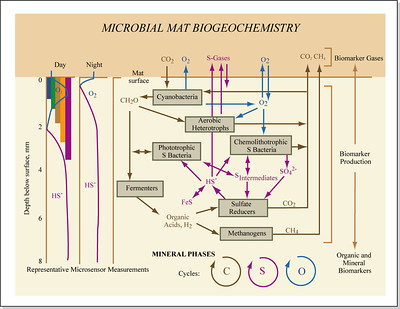Alright the main takeaway for me here is that holy moly game design is so hard I don’t know how ya’ll do it.
Some thoughts from me, a non-ecologist:
When considering niches, especially from a microbes point of view, heterogeneity across an area becomes less important. Dirt is dirt and water is water. Global changes are what make a real difference. Large, wide-scale changes in pH, temperature, presence of oxygen [usually bad], and salinity are some obvious ones. Pressure isn’t super important for microbes since they’re so small. Availability of metabolites becomes more important in a given area, with the gradients of these things across a given area the most important. For a really good visual of gradients, looking at microbial mats is a good start. Microbial mats can be thick, like a couple of cm, but generally are sub-1cm, but contain a TON of different would-be niches.

Microbial Mat Biogeochemistry from MIT open source
So I think scale is going to be important for what is and isn’t a niche. So I guess I’m thinking that what niches are available changes as your organism grows or shrinks?
Niches based on plant height is interesting. In the present day this is totally a thing for both the plants that essentially create these height-based niches, and then the animals that live in them. The appearance of these niches basically relies entirely on competition with your neighbors. If all plants start out as plant A which is 1cm tall, eventually you’re going to run out of horizontal room to add new members. This will cause die-off from overcrowding. And now it’s a race to mutate to survive. Will you grow taller to be closer to the light? Will you become more efficient at using the light you do get? Will you actively hurt your neighbors? Truly giant plants like trees, I think, don’t really appear until there’s grazing from non-plants. Growing tall or large is energetically expensive, but getting eaten or choked out is worse. So once you become multicellular “size” isn’t really the parameter. It’s going to contain several things like height, width and weight/mass.
The classic example of organisms adapting via height is the giraffe and the acacia tree. Acacia trees are the classic “umbrella” tree which have evolved to grow taller to avoid grazing by herbivores. Giraffes circumvented this by getting a really long neck. And then acacia’s grew thorns. And then giraffes grew a really long tongue. And then some other trees kind of like acacias decided that growing tall was too much work so they just jacked up their production of tannins so that eating them made you dehydrated. Side note: This last one I’ve gotten to test first hand in South Africa where a field guide let us eat leaves off a tree and literally it’s like your entire mouth becomes devoid of moisture. Very cool adaptation! 11/10 for tannins.
Okay I don’t know if any of that was even helpful but that’s sort of what I thought after reading through everything.